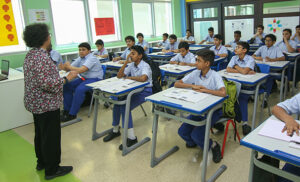Cursive handwriting, often regarded as an art form of written expression, offers more than just aesthetic value. It plays a crucial role in enhancing fine motor skills, especially for students taking school admission in pre-primary. By learning and practicing cursive writing, students engage their hand and finger muscles in a precise and coordinated manner, leading to improved dexterity and control over their writing instruments. This fine motor skill development is essential for various academic and practical activities, including note-taking, essay writing, and even everyday tasks such as signing documents or composing personal correspondence.
The intricate nature of cursive writing requires students to navigate fluidly between different letter forms, connecting them seamlessly in a continuous flow. This process demands a higher level of coordination between the hand, eye, and brain, leading to improved hand-eye coordination and spatial awareness. Additionally, the repetitive nature of practicing cursive writing helps strengthen the small muscles in the hands and fingers, promoting better control over pen pressure, letter formation, and overall handwriting quality. These refined motor skills not only contribute to legible and aesthetically pleasing penmanship but also have far-reaching implications for cognitive development, attention to detail, and academic success in various subjects that rely on written communication.
What is Cursive Handwriting?
Cursive handwriting is a style of writing that involves connecting letters together in a flowing and continuous manner. It is characterized by a distinct slant, loops, and ligatures, which differentiate it from print or block lettering. Cursive writing has a long history and has been used for centuries as a primary mode of written communication. It is often considered more elegant and aesthetically pleasing than other forms of handwriting.
One of the main features of cursive handwriting is the fluidity with which letters are joined together. Instead of lifting the pen or pencil between each letter, cursive requires a continuous motion, allowing the writer to create a smooth and uninterrupted stream of text. This flowing nature of cursive promotes writing speed and efficiency once mastered. Additionally, cursive writing has its own set of letterforms, with certain letters having unique loops and curves. This distinctive style can lend a sense of personality and individuality to one’s writing, making it a personal and artistic form of expression. Besides, in an era where technology dominates, embracing the art of cursive handwriting equips students with a timeless skill that fosters cognitive development, personal expression, and a deeper connection to the written word.
Helpful Cursive Handwriting Tips That Enhance Fine Motor Skills
In Dubai, cursive handwriting is an invaluable tool for the development of fine motor skills in children. But, if your child is experiencing cursive writing problems both at home and school, it is natural to worry about the potential impact on various aspects of their life. These challenges may adversely affect their self-esteem as they compare their handwriting to that of their peers. Additionally, students struggling with cursive handwriting at international schools in Dubai can develop frustration which can potentially manifest as a disruptive behavior at school or a negative attitude toward homework. Poor handwriting can also impact their grades and academic achievement, as it may hinder their ability to effectively communicate their knowledge and ideas on paper. It is crucial to address these issues promptly and provide the necessary support to help your child overcome their writing difficulties and succeed academically.
Here are 7 helpful cursive handwriting tips to develop and enhance fine motor skills in children.
1. Start With The Right Pencil Grip: A good pencil grip is crucial for developing smooth and controlled cursive handwriting. The tripod grip is the most common and recommended grip. To achieve the tripod grip, hold the pencil between your thumb, index finger, and middle finger. Your thumb and index finger should be on opposite sides of the pencil, while your middle finger rests in the middle for support.
2. Use A Light Touch: When writing in cursive, there’s no need to press hard on the paper. In fact, applying excessive pressure can make your handwriting worse. Instead, use a light touch and let the weight of the pencil do the work. This helps in maintaining a consistent flow and reduces strain on your hand.
3. Slow Down: It’s better to write slowly and carefully than to rush and make mistakes. By taking your time, you can focus on forming each letter accurately and maintaining proper spacing. As you gain more practice and familiarity with cursive, your writing speed will naturally increase without sacrificing legibility.
4. Practice Regularly: Consistent practice is key to improving your cursive handwriting. Set aside dedicated time each day to practice writing in cursive. Whether it’s a few minutes or a longer session, regular practice helps develop muscle memory and strengthens fine motor skills required for fluid and neat handwriting.

5. Use Tracing Paper: Tracing paper is an excellent tool for learning the shapes and strokes of cursive letters. Place a sheet of tracing paper over a model of cursive letters, such as a handwriting worksheet or a cursive alphabet chart. Trace the letters carefully, paying attention to the curves and connections. This helps you understand the proper formation and improves muscle memory.
6. Use Dotted Lines: Dotted lines can be helpful for maintaining consistent letter size and spacing. Begin by practicing on worksheets or paper with dotted lines, as they provide a visual guide. The dots can serve as reference points for letter height and help you keep your writing aligned and evenly spaced. Once you feel comfortable, gradually transition to writing on blank paper while maintaining the consistent sizing and spacing you learned from the dotted lines.
7. Use A Variety Of Activities: Engaging in various activities can make cursive handwriting practice more enjoyable and diverse. Instead of solely focusing on repetitive drills, try different writing exercises. For instance, you can write in a journal, compose letters to friends and family, or even create a secret code where you write messages in cursive. These activities not only enhance your handwriting but also provide practical contexts for utilizing cursive skills.
Why Learn Cursive Handwriting?
While cursive handwriting may not be as widely used as it once was in this digital age, there are many reasons that demonstrate the continued value and benefits that can be gained from learning this invaluable skill. Here are few good reasons why cursive writing is important in kindergarten:
1. Improved Writing Speed: Cursive writing generally enables faster writing compared to print. Since the letters in cursive are connected, there is a smoother flow between words, reducing the need to lift the pen repeatedly. This increased speed can be advantageous when taking notes or completing written assignments within a time constraint.
2. Cognitive Benefits: Writing in cursive engages both hemispheres of the brain, promoting cognitive development. It stimulates areas responsible for motor skills, memory, language, and creativity. This cognitive engagement can improve overall brain function and potentially enhance learning abilities.
3. Fine Motor Skill Development: Mastering cursive requires precise control of hand movements and finger dexterity. Regular practice of cursive writing can strengthen fine motor skills, leading to better control over pencil or pen movements. This can have a positive impact on other tasks that involve intricate finger movements.
4. Practicality in Note-Taking: Cursive writing’s fluidity makes it well-suited for taking notes, especially during lectures or meetings. Its continuous flow allows for efficient capturing of ideas and concepts, eliminating unnecessary pauses between words. This can enhance productivity and the ability to summarize information effectively.
4. Improved Hand-Eye Coordination: Learning cursive handwriting involves precise coordination between the eyes, hand, and brain. This coordination strengthens the neural connections between these areas, promoting better hand-eye coordination overall. Improved hand-eye coordination can be beneficial in various activities, including sports, art, and everyday tasks.
Don’t Miss Out: Life Skills Education For Kids – Using Interactive Activities
Conclusion
In conclusion, cursive handwriting skill has been found to significantly enhance fine motor skills in children. Through the intricate and continuous movements required to form cursive letters, individuals develop better control and coordination of their hand muscles. The fluidity and connectedness of cursive writing demand precise finger movements, encouraging the strengthening and dexterity of fine motor skills. Moreover, the practice of cursive handwriting engages both hemispheres of the brain, promoting the development of neural connections and cognitive functions associated with motor control. Therefore, incorporating cursive handwriting in educational curricula and encouraging its practice can effectively support the enhancement of fine motor skills in individuals, fostering improved manual dexterity and overall writing proficiency.
Frequently Asked Questions
Why Are Fine Motor Skills Important In Handwriting?
Fine motor skills refer to the ability to control small muscles in the hands and fingers, enabling precise movements. These skills are crucial for tasks like handwriting. Here are some reasons why fine motor skills are important in handwriting:
1. Legibility: Developing fine motor skills helps children achieve legible handwriting. The ability to control the small muscles allows them to form letters accurately and consistently, leading to readable writing.
2. Speed and fluency: With well-developed fine motor skills, children can write quickly and efficiently. They can maintain a steady hand and fluid movements, which contributes to increased writing speed and smoother penmanship.
3. Hand-eye coordination: Fine motor skills involve the coordination between the eyes and the hands. This coordination is necessary for guiding the hand in forming letters, maintaining proper spacing, and staying within the lines on a page.
4. Cognitive development: The process of handwriting itself aids cognitive development. Research suggests that the act of physically writing by hand engages different regions of the brain involved in memory, language processing, and critical thinking, supporting overall cognitive growth.
5. Pre-writing skills: Developing fine motor skills prepares children for other pre-writing activities. These skills include tracing shapes, drawing lines and curves, and practicing hand movements that lay the foundation for letter formation and more complex writing tasks.
How Does Cursive Writing Positively Affect The Brain?
Here are some ways in which cursive writing can benefit brain development:
1. Enhanced neural connections: When writing in cursive, the continuous flow of letters requires different and more intricate neural pathways compared to printing or typing. This can strengthen neural connections, promoting brain development and improving overall neural plasticity.
2. Improved fine motor skills: Cursive writing demands greater control over the hand and finger movements, which helps refine fine motor skills. The coordination required for forming connected letters can enhance dexterity and precision in writing and other manual tasks.
3. Language and memory integration: Research suggests that the physical act of writing by hand, including cursive writing, engages multiple regions of the brain associated with language processing and memory. This integration can improve comprehension, retention, and recall of written information.
4. Cognitive engagement: Cursive writing requires concentration and attention to detail, promoting mental engagement and focus. The deliberate and deliberate nature of forming cursive letters can enhance cognitive skills such as attention span, concentration, and information processing.
5. Personal expression and creativity: Cursive writing can also provide a medium for personal expression and creativity. The flowing nature of cursive allows for individual style and flair, fostering a sense of ownership over one’s writing and encouraging self-expression.
Should Children Be Encouraged To Write in Cursive Handwriting?
Whether or not children should be encouraged to write in cursive handwriting is a hotly debated topic. There are many arguments for and against teaching cursive.
Arguments in favor of teaching cursive:
● Cursive writing can improve fine motor skills and hand-eye coordination.
● It can help children develop better spelling and grammar skills.
● It can boost creativity and problem-solving skills.
● It can help children learn how to read more fluently.
Arguments against teaching cursive:
● Cursive is not as necessary in the digital age, as most people now type their notes and letters.
● It can be difficult to learn and master, especially for children with fine motor difficulties.
● It can be time-consuming to teach, as it takes up valuable instructional time.
● There is no clear evidence that cursive writing has any long-term benefits.
Ultimately, the decision of whether or not to teach cursive is a personal one. There are many factors to consider, such as the age of the child, the school’s curriculum, and what parents want. However, there is no doubt that cursive writing has some potential benefits, and it may be worth considering teaching it to children.
Why is Cursive Writing Important In Kindergarten?
Here are some reasons why cursive writing is important in kindergarten:
1. Foundational skills: Kindergarten is a crucial stage for developing foundational skills, including fine motor skills and hand-eye coordination. Introducing cursive writing in kindergarten allows children to begin honing these skills early on, setting a solid foundation for future writing tasks.
2. Early exposure and familiarity: Introducing cursive writing at a young age can familiarize children with the concept and appearance of cursive letters. This early exposure enables them to recognize and differentiate cursive writing when they encounter it in various contexts later in life.
3. Readiness for later learning: Learning cursive in kindergarten can prepare children for more advanced writing tasks in later grades. As they progress through their education, they may encounter assignments or examinations that require reading or producing written materials in cursive.
4. Cognitive development: The cognitive benefits associated with cursive writing, such as improved neural connections and enhanced memory integration, can be advantageous during the crucial developmental period of kindergarten. Engaging children in activities that involve cursive writing can support their cognitive growth.
5. Multisensory learning: Cursive writing often involves a multisensory approach, which can be beneficial for young learners. Tracing and writing cursive letters can engage multiple senses, such as touch and visual perception, fostering a more comprehensive learning experience.




























